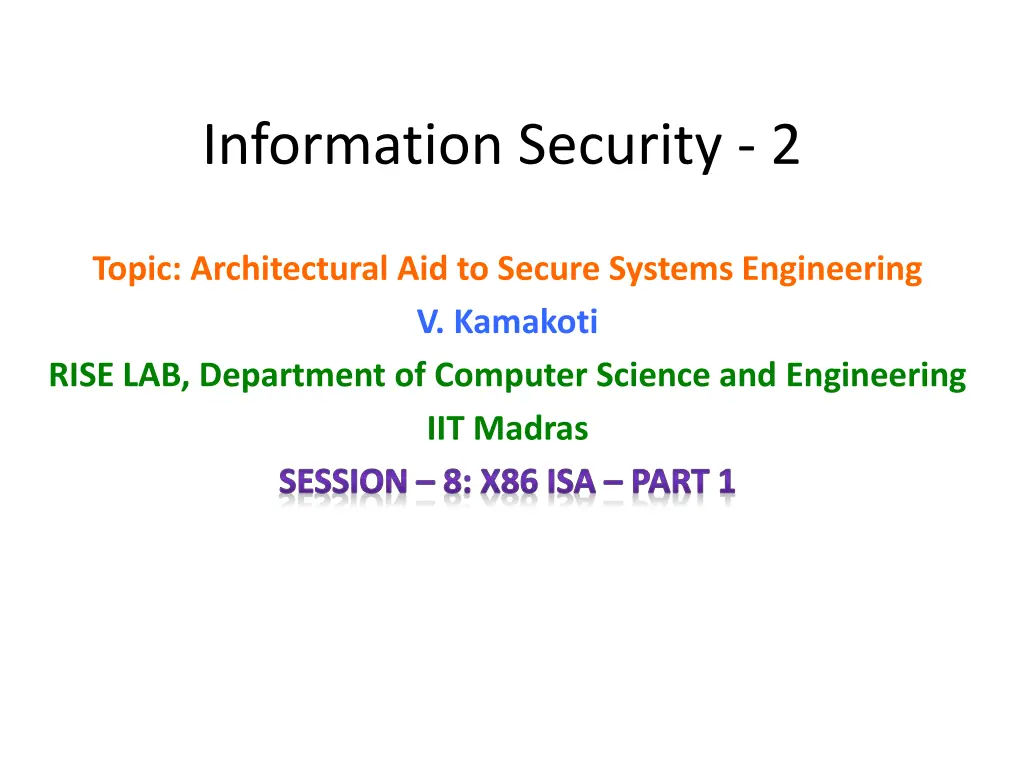
Architectural Aid for Secure Systems Engineering with X86 ISA Part 1
Explore the comparison between CISC and RISC architectures, delve into Intel's general purpose registers, and discover the segmentation features in X86 architecture. Learn about the multiple segments, different register types, and the process of context switching in a multiprocess setting.
Download Presentation

Please find below an Image/Link to download the presentation.
The content on the website is provided AS IS for your information and personal use only. It may not be sold, licensed, or shared on other websites without obtaining consent from the author. If you encounter any issues during the download, it is possible that the publisher has removed the file from their server.
You are allowed to download the files provided on this website for personal or commercial use, subject to the condition that they are used lawfully. All files are the property of their respective owners.
The content on the website is provided AS IS for your information and personal use only. It may not be sold, licensed, or shared on other websites without obtaining consent from the author.
E N D
Presentation Transcript
Information Security - 2 Topic: Architectural Aid to Secure Systems Engineering V. Kamakoti RISE LAB, Department of Computer Science and Engineering IIT Madras SESSION 8: X86 ISA PART 1
CISC Vs RISC X86 is CISC while ARM is RISC CISC is Compiler s heaven while RISC is Architecture s heaven Orthogonal ISA in RISC Fixed format that is easy to decode Programming Language to Execution involves two levels of translation Compilation by compiler Interpretation by Instruction decoder
64-bit and above Registers RAX, RBX, RCX, RDX, RSI, RSP, RDI, RBP 64 bit General purpose registers sharing space with its corresponding 32-bit registers R8-R15, additional general purpose registers R8D R15D (32 bit counter part) R8W R15W (16 bit counter part) ST0-ST7, 80 bit floating point MMX0-MMX7, 64-bit multi media XMM0-XMM7, 128-bit registers used for floating point and packed integer arithmetic
Multiple Segments The segment register can change its values to point to different segments at different times. X86 architecture provides additional segment registers to access multi data segments at the same time. DS, ES, FS and GS X86 supports a separate Stack Segment Register (SS) and a Code segment Register (CS) in addition. By default a segment register is fixed for every instruction, for all the memory access performed by it. For eg. all data accessed by MOV instruction take DS as the default segment register. An segment override prefix is attached to an instruction to change the segment register it uses for memory data access.
0000 mov [10], eax DS - this will move the contents of eax register to memory location 0510 0500 Opcode: 0x89 0x05 0510 mov [ES:10], eax 1500 CS -this will move the contents of eax register to memory location 3510 2500 SS Opcode 0x26 0x89 0x05 0510 0x26 is the segment override prefix. 3500 ES Multiple Segments
Process 1 CS CS Process 1 DS Process 1 in Execution Process 2 CS DS Process 2 SS SS Process 2 DS Process 2 Process 1 SS in Execution Multiprocess Context switching
Other System Registers Control CR0, CR2, CR3 (each 32-bits) CR0 is very important Bit 0 PE bit when set processor in protected mode else real mode Bit 3 TS bit The processor sets this bit automatically every time it performs a task switch. This can be cleared using a CLTS instruction Bit 31 PG bit when set paging MMU is enabled else it is disabled
Other System Registers Control CR0, CR2, CR3 (each 32-bits) CR2 Read only register deposits the last 32-bit linear address that caused a page-fault CR3 Stores the physical address of the PDB Page Directory Base register. The paging tables are to be 4KB aligned and hence the 12 least significant bits are not stored and ignored
Other System Registers Debug Registers DR0, DR1, DR2, DR3, DR6, DR7 DR0-DR3 can hold four linear address breakpoints so that if the processor generates these addresses a debug exception (Interrupt 1) is caused DR6 Debug status register indicating the circumstances that may have caused the last debug fault DR7 Debug control register. By filling in the various fields of this register, you can control the operation of the four linear address breakpoints
End of Session-8 Thank You
